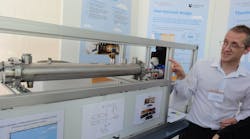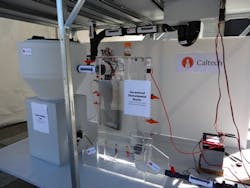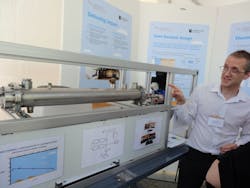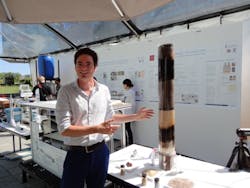SEATTLE — Bill Gates changed how the world works. Now his Foundation aims to change how the world uses the toilet. In August, the Bill & Melinda Gates Foundation hosted its first ever Reinvent the Toilet Fair, a year after announcing its Reinvent The Toilet Challenge (RTTC). More than 40 universities and non-government organizations (NGOs) exhibited their progress on the Foundation’s Seattle campus. Many competed for a chance to receive additional grants.
At first blush, scanning the exhibits, an attendee might think he had stepped into a mad scientist’s laboratory. Windmills, solar panels, bubbling tubes and feces-consuming larvae aren’t exactly what you’d pick up at your local supply house counter.
Jim McHale of American Standard shows the trap door model to an attendee.
Which is exactly the point, Gates says.
“The toilet that was invented 200 years ago, the flush toilet, really hasn’t had that many milestones,” Gates told the assembly of about 200 invitation-only attendees. “If (Thomas) Crapper was reborn today and he had gone to the toilet, (he would) find it quite familiar.”
The point of the RTTC is to bring safe sanitation to the 40% of the world’s population who live without sewer and piping infrastructure and with limited natural resources. “The current design (of the toilet) has a real problem,” Gates said. “It uses a lot of water, and requires very expensive systems to bring in very clean water. Then you have a very expensive system to take it away, and then you have a treatment plant. Even in middle-income countries it’s a problem, not to mention the poorest countries.”
The Foundation challenge to grantees, therefore, required inventions to operate without connections to water, sewer, or electrical lines, cost less than five cents per user per day in combined capital and operation expenses, and to destroy waste or convert it to valuable resources.
Perhaps most challenging of all, the next generation toilets need to be aspirational, something people will want to buy. Human nature being what it is, it’s not automatically assured that everyone will clamor to spend even the small amount required to protect the health of their nations. “It’s not just science and engineering involved, it’s what human beings expect, what is attractive,” the Microsoft founder said.
Straight out of science fiction
The Gates Foundation reported grants totally nearly $400,000 to eight universities competing in the RTTC, and made awards at the Fair to systems judged to be most innovative. The top three included:
A self-contained solar-powered toilet and wastewater treatment system from the California Institute of Technology took first place at the fair. In this design, a solar panel powers an electrochemical reactor that breaks down waste into hydrogen and electricity. The hydrogen is then stored for use in fuel cells to power the system at night or in low-sunlight conditions.
The first place winning system from the California Institute of Technology.
The second place winner from Loughborough University in the UK transforms feces into a biological charcoal through a process called hydrothermal carbonization that decomposes feces at high temperatures without oxygen or water into a form of charcoal that powers the system. The system also recovers water and salts from feces and urine.
The hydrothermal carbonization chamber developed by Loughborough University.
A sand filter and ultra-violet light that converts urine to clean water was part of the third place winning system from the University of Toronto that also includes a belt system to flatten feces and then sanitize it through 24 hours of smoldering.
The sand filter to disinfect urine from the University of Toronto.
While some of these systems may be deployed in less than four years, it is still unclear how to train a ground force of installers from a labor pool with limited educational opportunities. All the winners interviewed said the installation part of the equation would be addressed in the next phase of development.
Turning to the plumbing industry
Four years is a long time with more than a million and half childhood deaths annually due to diarrhea. This is one of the reasons the Gates Foundation partnered with American Standard Brands to adapt present-day knowledge for short term solutions.
“Our expertise here at American Standard is not really in the processing of waste, it’s more in the user interface with the toilet” said Jim McHale, vice president of engineering, who first approached the Gates Foundation offering to help with the initiative. “We know how to design a toilet that effectively and reliably removes the waste.”
Following a fact-finding trip to Bangladesh in March, McHale and product engineer Daigo Ishiyama formulated two prototypes to improve the pour flush latrine used in many areas of South Asia. A plastic formation shaped like a narrow toilet bowl is encased in concrete. Users fill a small teapot-shaped container called a bodna that holds about 1.5 liters of water, and pour it into the latrine after use.
The “trap” is an oblong-shaped cup bolted onto the bottom of the main plastic piece. In theory, the trap seals off the open pit, but in practice, the odd shape often results in a problem all too familiar to people in developing countries: the waste gets stuck in the cup. “People told us they use a stick to break off the cup,” exposing the pit to the air where flies can pick up and spread pathogens, McHale said.
Using computational fluid dynamics, McHale and Ishiyama reengineered the plastic part, showcasing two possible solutions at the fair. The first had the trap molded right into the plastic, at an angle that facilitated waste removal, instead of trapping it. The second included a trap door at the bottom of the plastic piece. McHale estimated that the cost per piece would be 55 cents and 85 cents to manufacture in Bangladesh, vs. the 35 cent piece currently being used.
The immediacy of the solution captured the attention of fair attendees from many of the 29 countries represented, with some actually attempting to place orders. “We still have a few tweaks we want to make, and then the next step is field testing in Bangladesh this fall,” McHale said.
‘A hidden international scandal’
Many speakers and attendees lauded the Foundation for tackling the indelicate subject of sanitation, “a hidden international scandal,” said the Prince of Orange, chair of the United Nations Secretary General’s Advisory Board on Water and Sanitation.
Gates admitted he’s learned a lot about toilets in the last year. “I’m getting smarter about sanitation all the time, because it’s such an important topic.
“A central tenet of my career is that it’s possible to make breakthrough innovations. We don’t just have to accept the way things are done.”






